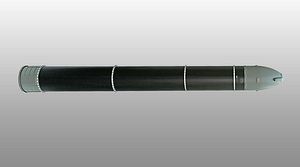Russia will test launch its deadliest nuclear weapon currently under development, the new super-heavy thermonuclear-armed intercontinental-range ballistic missile (ICBM) RS-28 Sarmat (NATO designation: SS-X-30 Satan 2) twice before the year’s end, according to Russian defense ministry sources. The missile is expected to be fired from a silo at the Plesetsk space center, located in Arkhangelsk Oblast, approximately 800 kilometers north of Moscow.
The first test launch of this year was originally scheduled for March. Then it was moved to April due to the need for additional tests of hardware components in the Sarmat’s test stands. From April, the test was rescheduled to July and then to the fall. As I reported in March, the Sarmat’s ejection test alone — which tests the mechanism of a missile leaving its launch container — had to be postponed over five times. (Originally, the first ejection test was to occur in 2015, but was then pushed back to 2016 and now to the last quarter of 2017.)
According to Russian media reports, the technical reasons for the delay have now been addressed. However, the missile is most certainly not near mass-production as some Russian analysts have suggested. Up until now, the missile has only been tested once. “So far, we know of one single test of the new weapon system. In August 2016, the Sarmat’s first stage engine, named PDU-99, was tested. Analysts believe that the engine is a modified version of the RD-274 liquid rocket engine used on the RS-36M ICBMs. However, it is unclear whether the test was successful or not,” I reported this January.
The Sarmat is expected to enter service by 2020, replacing Soviet era RS-36M ICBMs, which has been the backbone of Russia’s strategic nuclear forces for the past 25 years. The Sarmat is slated to become the mainstay of the Russian Strategic Missile Force’s silo-based ICBM force going into the 2020s. Consequently, a delay in this high priority nuclear weapons program could be interpreted as another sign that Russia is struggling to modernize its nuclear forces. As I reported in March:
Additional circumstantial evidence that not all is well with the Sarmat program is the Russian defense minister’s request for weekly status reports, according to the Russian Nuclear Forces Project (RNFP):
He promised that the ministry of defense will demand weekly reports on the progress with development of ‘prospective strategic missile systems’ that are built at Krasmash [a Russian defense contractor building nuclear weapons for the Russian Strategic Missile Force].
“The Sarmat can reportedly carry ten heavy or 15 (some sources say 16) lighter warheads. The new ICBM can allegedly also be fitted with a new hypersonic glide vehicle (HGV), the YU-71, currently in development under the secret Project 4202.” I explained previously. “The YU-71 is a warhead purportedly capable of penetrating any Western missile defense system.” Each warhead purportedly has an explosive yield of up to 750 kilotons.
The Sarmat will reportedly be twice as light as the RS-36M.
In October 2016, the Makeyev Rocket Design Bureau posted a declassified picture of the prospective new missile on its website for the first time. The missile is being build by the Krasnoyarsk Machine-Building Plant.
































